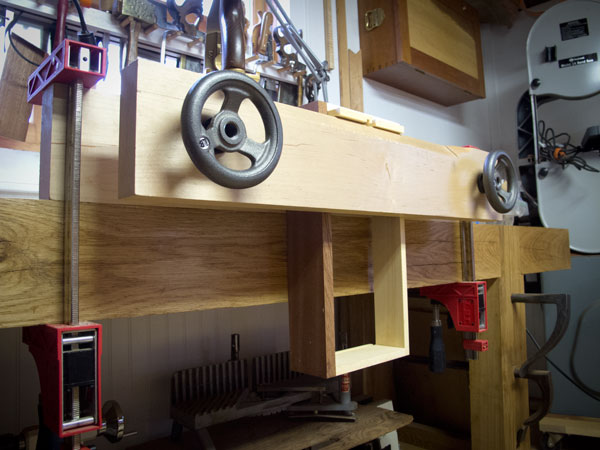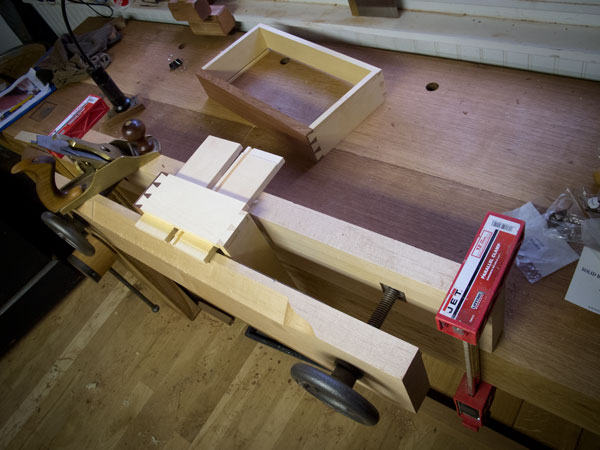We may receive a commission when you use our affiliate links. However, this does not impact our recommendations.
Almost every day I get some sort of question about the ‘Moxon vise,” a double-screw vise that I wrote about for the December 2010 issue of Popular Woodworking Magazine. It’s an ingenious portable vise that has been around for almost 400 years, yet it still generates controversy and questions whenever it is in the limelight.
I know this blog entry won’t stop the questions, but it might help you decide if it is something you should make for your shop.
1. Did Joseph Moxon invent the vise?
Absolutely not. As far as we know, Joseph Moxon wasn’t a woodworker. He was a globe-maker, printer and maker of mathematical instruments. He described the double-screw vise in the first English-language book on woodworking, “Mechanick Exercises.” Here’s what he wrote:
“Sometimes a double Screw is fixed to the ſide of the Bench, as at g; or sometime its farther Cheek is laid an edge upon the flat of the Bench and faſtned with an Hold-faſt, or, sometimes, two on the Bench.”
The double-screw vise shows up in other works, such as the Randle Holme’s “Academy of Armor” and Andre Felebien’s “Principes de l’architecture.” And it could have been a jig that is even older – I haven’t dug deep on this issue.
2. Was it intended for dovetailing?
Hard to say. Based on Moxon’s description, we have no evidence how it was used. Andre Roubo featured this vise in his 18th-century masterwork (read all about it here). My crude translation of the text goes something like this:
“We use these presses on the workbench with the rip tip, either for work or work to stick. In one or other of these different cases, we stop the press on the bench with two (holdfasts so) that it (will not move).”
So these vises could be used for a ripping operation. Perhaps tenon cheeks, dovetails or something else entirely.
3. Does the front jaw have to be wider than the rear jaw?
In my article on the vise in 2010, I made the movable front jaw a smidge wider than the rear jaw. This was to make the vise easy to perch on the front edge of a benchtop. It is not an original detail from an early source. So if you want an authentic double-screw vise, skip this detail.
4. Are your dimensions correct?
Here is what Roubo wrote about this vise:
“These presses are composed of twin (chops) AB & CD, which are 5 to 6 inches wide, (and) about 3 to 4 inches thick, because of their length, which varies from 2 to 4 feet….”
5. Why don’t we find a lot of these vises “in the wild?”
Shop appliances don’t seem to survive as well as tools or workbenches. Shooting boards are rare finds. Have you seen many 17th-century bench hooks? Most have been used up or discarded. Some portable vises do show up, but they are not as common as anything that has a steel cutting edge, such as a plane or chisel.
6. Should I make my own screws, buy the ones from Benchcrafted or do something else?
This is your call. I have made about 200 wooden screws for these vises using the sub-optimal Taiwanese/Chinese tap and wood screw kit. These cost good money and work poorly. If you really want to make wood screws, consider the Beall wood-threading kit. It works very well. But you have to have a router and spend the $100 for the kit.
If you aren’t planning on making lots of these vises, the Benchcrafted kit is a great choice. For $149 you get the handwheels and screws. No need for a threadbox, tap or lathe.
I have the Benchcrafted hardware on my vise and could not be happier. Yes, I paid full retail for the hardware, blah, blah, blah.
7. Why do you call it the ‘Moxon vise?’
Double-screw vises have been invented and re-invented many times during the last 400 years. You can call them whatever you please. When I finally figured out the vise for myself, I was reading Moxon’s description of it. So that is the name I gave it. Feel free to call yours “Randle,” “Andre” or “Tipplewait.” The name is insignificant compared to what it can do to help you cut joinery.
— Christopher Schwarz
Here are some supplies and tools we find essential in our everyday work around the shop. We may receive a commission from sales referred by our links; however, we have carefully selected these products for their usefulness and quality.












Hi Chris,
Does the front chop slide directly on the screws or is there a bush inserted to prevent the hole in the chop wearing?
I like many others have added a small bench top bench behind the vise. I know you use a small “precision made” block of wood to support your pieces as you knife the lines for your pins. Have you seen any 18th century or earlier bench top bench additions to the vise?
I took the non-metal fabricating approach and just used veneer press screws on mine. There’s no garter so I have to pull the front jaw out for some work, but I found them on line for about $15 each. Cheaper than I could get all the pieces to do it myself.
[Hint]Isn’t it about time that those nice folks at Veritas made some thread cutting equipment?[/Hint]
It might be time for me to bite the bullet and purchase the Benchcrafted edition of the Moxon Vice hardware. In your photographs you show the vice holding a drawer. The Benchcrafted model opens about 2 1/4 “–is your drawer height higher that 2 1/4” or do you have longer Acme screws?
If I’m cheap, what wood would be the best for a cheap Chinese-made tap?
If you have the ability to do a little metal working (grinding and drilling) you can get Acme threaded rods and cast wheels from McMaster Carr. Since I wanted a thicker front chop (3″ thick) to accommodate dogs and still keep a useful working width between the chops I used a longer Acme rod with 5 TPI. Anyhow, you can likely find whatever you need. I did have a minor issue with getting a few nuts that had the wrong thread and needed to order replacements, but nuts are pretty cheap. All together the 2 rods, 2 wheels, and 4 nuts cost me around $80 with shipping.
The Benchcrafted stuff is great, but I didn’t want to spend that much. Since I have access to a welder, I made a couple of giant wing nuts by welding (at an angle) some rod onto a couple of nuts. It worked great. I think all said and done I have $25 in the hardware. I used regular 3/4″ all thread, but if I have to do it again, I would spend a little more and get some acme all thread.
Hi Chris,
You have mentioned on more than one occasion about the poor quality of Asian taps and screwboxes. Have you ever made a set yourself from the ground up? In an old FWW magazine (I have it in their Techniques 1 book) Richard Starr demonstrated a method of creating a tap and threadbox of any size. It’s a seven page article – quite detailed. Although I haven’t made one myself, it is within my capabilities (and most other woodworkers I bet) if my motivation is sufficient, and other projects arent.
Is there is a bevel on the top front of the outer jaw? It looks like it in both photos. If so, why?
Thanks for the post.
I agree with the translation of Roubo’s line, I read it as: “Those vises are used on the bench for (rip)sawing on a vertical piece, to work on the workpiece or to glue. In all these cases the vise may be fixed to the bench with holdfasts.” Knowing that most of the time rip sawing was done with the boards set flat on the bench using a frame saw.
Regarding 17th century bench hooks, funnily enough one from the Swedish ship Vasa can be seen on Roald Renmælmo’s HyvelBenk blog. Although in fairness to the point that shop appliances don’t often survive, the only reason this one is still around is that the ship sank with the bench hook in it.
http://hyvelbenk.wordpress.com/2014/01/16/kombinert-stotbrett-gjerkasse-i-verktoysamlinga-fra-vasaskipet/
I sure wish people would stop obsessing about dimensions! I made one using scrap 2×4’s and all thread. It’s not as nice as the benchcrafted version, but it works amazingly well considering the materials used. It was meant to be a temporary appliance until I could build a full size one, but I might not need one that big.